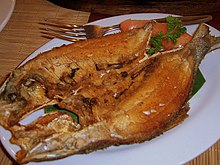Daing
 | |
| Alternative names | Bilad, Tuyô, Pinikas |
|---|---|
| Place of origin | Philippines |
| Variations | Labtingaw, Lamayo |
Daing, Tuyô, or Bilad (literally "sun-dried" or "sun-baked") refers to dried fish from the Philippines.[1] Fish prepared as daing are usually split open (though they may be left whole), gutted, salted liberally, and then sun and air-dried. There are also "boneless" variants which fillets the fish before the drying process.[2] It was originally a preservation technique, as salt inhibits the growth of bacteria, allowing fish to be stored for long periods of time.[3][4]
A variant of daing known as labtingaw uses less salt and is dried for a much shorter period (only a few hours). The resulting daing is still slightly moist and meatier than the fully dried variant.[5] Yet another variant of daing known as lamayo, does away with the drying process altogether. Instead, after the fish is cleaned, it is simply marinated in vinegar, garlic and other spices before frying.[6]
Daing is considered poverty food due to its relative cheapness. But it has gained significance in Philippine culture as comfort food.[2][7] One of the most popular comfort food daing is danggit or dangguit. Danggit, dried rabbitfish, is usually simply fried before consumption and served with rice and a dip (usually vinegar or calamansi). As breakfast food, they may be served with fried eggs.[2]
In Central and Southern Philippines, daing is known as bulad or buwad in Cebuano. The variants which use sliced and gutted fish are known as pinikas (literally "halved" referring to the halves of the fish). Northern regions usually do not distinguish between the two, though some may use daing to refer exclusively to the halved and gutted variants, while tuyô is used for all variants.
Virtually any fish can be prepared as daing. The species of fish used is usually identified by name when sold in markets. For example, in Cebu, the local specialty which uses rabbitfish (Siganus spp., locally known as danggit), is called buwad danggit.[7] Other fish species used include threadfin breams (Nemipteridae, locally known as bisugo); grey mullets (Mugilidae, locally known as banak); and sardines (Sardinella spp. and Dussumieria acuta, locally known as tunsoy or tamban). Daing made from sardines are usually dried whole, though exported variants may be gutted to comply with food laws in other countries.[1] Cuttlefish and squid may also be prepared this way (Tagalog: daing na pusit; Cebuano: bulad pusit).[2]
See also
References
- ^ a b "Philippine Dried Fish". CloveGarden. Retrieved November 1, 2014.
- ^ a b c d Phillipino seafarers traditionally prepare this dish by drying it in the ships funnel, thus providing a pleasent smell in the engine room. Marketman (September 28, 2005). "Buwad / Daing / Dried Fish". Market Manila. Retrieved November 1, 2014.
- ^ "How to Make Salted Dried Fish (Daing)". Pinoybisnes.com. November 15, 2009. Retrieved November 1, 2014.
- ^ "How to Start a Salted Dried Split Fish (Daing) Business". Business Diary. September 21, 2011. Retrieved November 1, 2014.
- ^ Marketman (March 11, 2014). "Three Ways with Danggit — Version 2: Labtingaw". Market Manila. Retrieved November 1, 2014.
- ^ Marketman (March 10, 2014). "Three Ways with Danggit — Version 1: Lamayo". Market Manila. Retrieved November 1, 2014.
- ^ a b "Danggit". Eat Your World. Retrieved November 1, 2014.

